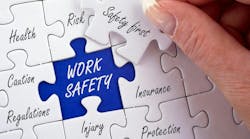In the construction industry, many insurance providers and general contractors look at a company’s overall safety performance when evaluating a company. One general indicator of safety performance is something called the experience modification rating (EMR). This rating is determined by insurance companies, and the number is derived from a combination of a company’s average losses and the possibility of future risks or events. The rating is compared to other companies who are in the same industry. Overall, the final rating is heavily influenced by a company’s claims due to their historical losses, which carriers will use to “predict” future losses.
The industry standard or average when it comes to an experience modification rate is 1. If a company has a rate lower than 1, this means that the company is operating at a low risk level and will have great workers compensation premium options. When a company has an EMR over 1, the insurance premium is more expensive and job bidding competitiveness is harder.
Here is how to get your company back on track if your company EMR is heading in the wrong direction.
Complete a worker’s compensation trend analysis of your company’s losses.
This is an important first step in determining the best course of action for your company. To understand the company’s losses is crucial in understanding what trends have developed over time. When reviewing your company’s loss runs, which can be provided by your insurance carrier, look at the root cause of each claim and determine what produced the injury or loss. This will allow a company to find current loss trends and help come up with a solution to stop these from happening in the future.
Review claim handling processes and incident reporting.
Claim handling at a company can make or break a its EMR. Claim handling should be efficient and streamlined. Internally, the office claims should be reported to your insurance carrier the same day the loss occurs. This allows the insurance carrier to have a record of this claim and begin the overall claim process.
Field workers should be trained in claim reporting procedures as well. Injuries should be reported the same day an injury occurs. Late reporting should not be tolerated as this could lead to claim handling issues in the future.
Review or implement a return-to-work program.
Return-to-work programs are crucial in successful worker’s compensation programs. Light-duty work gets employees back to work and gives the employee an incentive to get back to regular work duties. Light duty work can come in many forms where it adheres to occupational health and safety medical restrictions.
Conduct an all-company safety day.
This is an opportunity to paint a larger picture of safety culture at a company. This serves a dual purpose. First, companies can bring attention to ongoing safety issues occurring throughout the organization. Secondly, a safety day gives the opportunity for employees to step away from their regular job duties and receive some cool company swag or potentially a new training certification. This is a win-win for any company who is looking to not only improve their EMR but also improve the importance of safety first throughout the company.
Implement an employee safety training schedule.
Once a risk or loss trend has been identified, a company should use the opportunity and information to train their employees. Training completed on loss trends will in theory help reduce the risk in the future. Training can be completed in person or through online learning management systems.
Review key performance indicators (KPIs) regarding safety data.
Safety data collection and review is another important aspect of EMR correction, including both historical and quarterly data. A company should be reviewing reporting injuries, OSHA recordables, DART rates, case rates and safety observations annually if not more. All this information can help progress a company’s safety program substantially.




